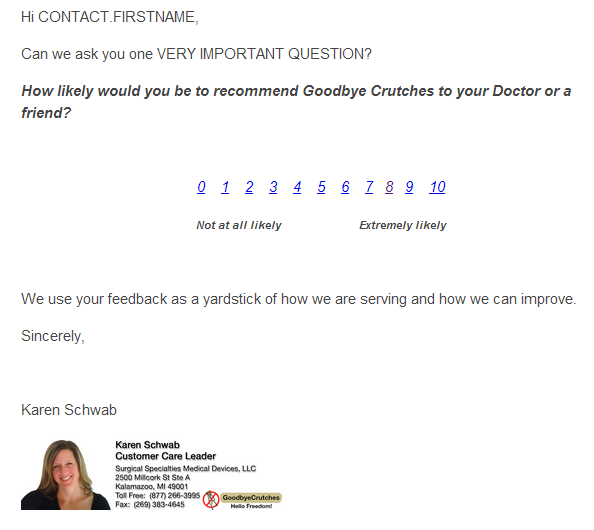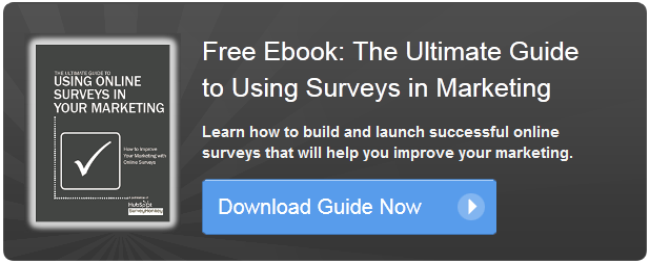 Many ecommerce marketers use post-transactional and post-delivery nurturing emails to gauge how their customers are responding to their products and services. As we know, customer happiness and satisfaction is an important motivating factor in whether or not you retain that customer and hit your goals for your most important metric. However, marketers have to balance between the amount of data that they need to gather statistically significant results and respecting the fact that not all consumers are willing to invest in giving feedback on lengthy surveys.
Many ecommerce marketers use post-transactional and post-delivery nurturing emails to gauge how their customers are responding to their products and services. As we know, customer happiness and satisfaction is an important motivating factor in whether or not you retain that customer and hit your goals for your most important metric. However, marketers have to balance between the amount of data that they need to gather statistically significant results and respecting the fact that not all consumers are willing to invest in giving feedback on lengthy surveys.
Ecommerce businesses are more likely, in general, to have complex problems with many variables than other businesses. Ecommerce websites are often dealing with tens of thousands or hundreds of thousands of new customers per month - making manual surveying and follow-up impossible. However, that scale also makes identifying areas of improvement even more vital for ecommerce over other businesses, since even minor changes in performance are replicated across a large number of customers and can have a significant increase on the business.
A significant depth of data is required in order for you to be able to identify trends and correlations for improvement. In addition to making sure that you have an overall level of statistical significance, you'll want to make sure that you have enough data points that you can mesh responses together to discover your business's leverage.
For example, if you survey 1,000 customers and ask each of them to rate their feedback on the condition of the product when it was delivered and want to see if that is related to whether or not they become a repeat customer, your sample size population probably isn't the whole 1,000 - and you have to make sure it's enough to get you a significant result.
Because of this, ecommerce marketers are often tempted to send giant, onerous surveys ask sometimes up to 20+ different questions. They rely on the fact that enough customers will be highly motivated enough to answer that many questions. However, customers who are that motivated may not be numerous enough to get you the number of responses you need to make intelligent decisions. Worse, requiring such a high threshold for motivation might mean that your data skews towards a small group of customers with powerful motivations - and possibly very costly ones.
Here's an example of a post-transactional survey sent by Delta:

As you can see, the survey is painful on the eyes. I'm sorry I had to do that to you. Only highly motivated (or very bored) customers are going to take the time to fill this survey out. What's worse, even though respondents will mostly be strongly motivated either positively or negatively, they make it clear at the bottom in red that no one is going to act on your answers. If I rate them very poorly on everything, I won't get any response from someone who can help me. If I rave about their service, I won't get any email response asking me to share my rave reviews publicly or in social media.
The extreme flip side of this method are the extremely simple, one-question surveys that most sophisticated inbound marketers use, such as this email by GoodbyeCrutches (you can read the full explanation of his methodology here).

This has the advantage of very clearly and easily asking for customer feedback. Also, in this company's case, someone clicking a response button of less than 7 triggers and immediate customer service follow up and someone clicking a 9 or 10 triggers a follow up with lazy social shares (such as lazy tweets) and links to review sites. If you've ever read "Influence: The Psychology of Persuasion", you'll know that people feel strongly compelled to remain consistent with their previous statements, so if they say they're likely to refer you then you should give them a chance to do so easily and immediately. (Side note: If you haven't read that book, you really should.)
However, this approach - while great for the majority of customers and valuable for rapidly responding to customers - limits the amount of data that you can gather and make decisions based upon. Customers motivated enough to provide additional information should have a chance to do so. Particularly if you're able to easily build landing pages that ask for feedback and correlate that information to a centralized customer contact record so that you can act on it - never ignore customer behaviors as strong as survey feedback - you don't want to lose out on valuable data that you could use to implement more in-depth changes to your processes and business. Delta, for example, should be able to analyze whether or not people who rate food poorly are more or less likely to fly repeatedly to determine whether or not to invest in saltier peanuts.
What I'd suggest is a hybrid approach to these two models. The second design - the clean and simple design - is clearly the best for sending to customers. It renders better on mobile, its purpose is more clearly understood by the recipient, it's less friction to receive feedback, etc. However, having a secondary call-to-action in the email underneath that that says something like "Have a lot more to say? Click here to take our customer feedback survey and make your voice heard." or something to that effect could help more highly motivated recipients to have an outlet for more detailed responses. Also, on the landing page that the response links direct to, you can have a CTA to take the more detailed survey.
This will expand the number of customers that engage with feedback at least on a basic level. It doesn't have to be all or nothing when it comes to customer communication. Also, because you'll always want to tie the responses back to a centralized customer contact database, you'll be able to monitor trends over time and create a truly inbound and awesome experience for your customer. For example, if I rate Delta's food poorly after this flight and they make a change some time down the road and then I fly with them again, they should send me a follow up asking for my updated thoughts on that specific question. It can have a huge impact on customers when it seems like the brand is simply listening to them.
The key to any method is, of course, to act on the data. If a customer responds negatively to a survey, trigger an automated follow up email. It's not that hard, and it can change the whole context of your relationship with the customer.



